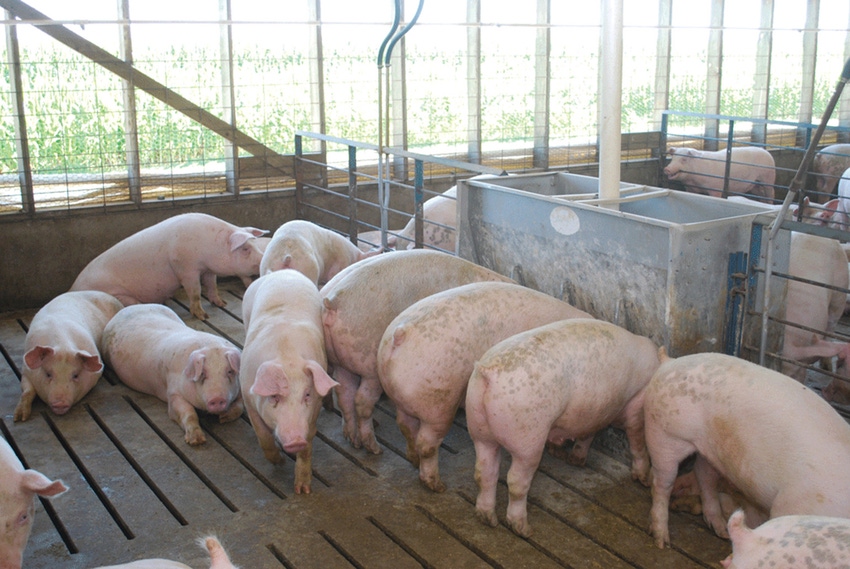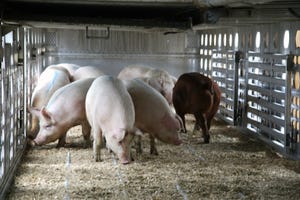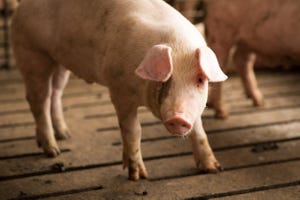Evaluating pork quality of the whole hog
Measuring pork quality can be a tricky thing as consumers’ tastes vary as much as consumers themselves, but what about quality variances within an individual pork carcass?
August 14, 2017

Pork quality is a major concern, as it should be since producers want to provide consumers with the best quality product so those consumers will be repeat customers.
Measuring pork quality can be a tricky thing as consumers’ tastes vary as much as consumers themselves, but what about quality variances within an individual pork carcass? Dustin Boler, assistant professor in the Animal Sciences Department at the University of Illinois, says pork carcasses are often graded for the quality of the loin area, but does a quality loin translate to a quality ham or quality in the shoulder? He says the quality of loins is often determined by color, tenderness, pH, “kind of depends upon the audience, but that’s kind of the grocery basket of traits that people measure and extrapolate that to the carcass and say this is quality or this is not.”
There has not been a correlation of quality in the loin to quality in the ham or shoulder. Boler explains that in beef carcasses quality is established at the 12th or 13th rib, “so if it’s a ‘prime’ at that location, then it’s a prime carcass. … Pork carcasses are not evaluated that way, it’s really kind of commodity pork or export pork.”
National Pork Board, which funded the project, sought to increase understanding of pork quality on an overall carcass perspective, allowing Boler and fellow researchers to “chase” the potential correlation between loin quality and ham and shoulder quality.
This research, which included University of Illinois graduate students, USDA meat science researchers and a representative from Smithfield Foods, played out on a grand scale to be applicable to commercial hog producers. Researchers had access to eight barns of pigs for a total of 8,000 pigs that were raised in winter and summer conditions to allow for seasonal vagaries that may occur, and the possible impact on carcass quality.
Research parameters included barrows and gilts, as well as production systems seeking lean carcass and systems with quality goals. “Other than that, we tried to stay blind as to what was actually taking place in the barns,” Boler says. “We wanted to be as relevant as we possibly could” so the results could be used in U.S. hog production facilities. All of the pigs were Midwest pigs that ended up being processed in the same facility.
“Our focus was not necessarily on the live side; our real objective was to characterize quality in relationship to quality parameters within what the plant would observe. The plant doesn’t become engaged with these pigs until they show up in their lairage pens, so we didn’t become engaged in the pigs for this particular project until they were in lairage,” he says.
This research could have been done at the university meat lab on about 50 pigs, but that would not necessarily translate very well to commercial production. Anna Dilger, an associate professor in the University of Illinois Animal Sciences Department, says, “It was exciting for us; to be able to do this scope of work you really need to have thousands of pigs, so through the partnership with the plant and other scientists to be able to view that many pigs means we feel confident in the relationships that we saw.”
So far research results have been published in five articles, with another yet to come.
In the first article, the team looked at correlations between loin quality and quality of the belly and ham from the same pig. In this case, quality was defined mostly by color and tenderness. “Color is what drives whether or not a consumer purchases a particular pork chop. It translates into what we think of as purchase intent, Boler says. “After that, we look at whether a product is tender. If it is tender enough, we think that will translate into a repeat purchase.”
Unfortunately, the team found no correlation between loin quality and the quality of other cuts. “Just because a loin has desirable color and is tender doesn’t mean the same animal is going to produce a good belly for bacon or a great ham for a special dinner. It didn’t,” Boler says.
Researchers concluded that the lack of strong correlations between the loin and ham may be due to differences in chilling rates. Loins reached ambient temperature at approximately 14 hours postmortem, but hams did not reach ambient temperatures, even after 22 hours of chilling. Lack of relationships between the loin and belly may be due to compositional differences.
Fresh bellies may be as much as 40% extractable lipid, while loins are likely no more than 5% extractable lipid. Using loin quality to draw conclusions about belly, fresh ham or cured ham quality may be misleading. A carcass with a high-quality loin will not necessarily yield a high-quality belly or ham. To understand whole-carcass quality, loin, belly, fresh ham and cured ham quality must be evaluated individually.
The rest of the articles focused on understanding the variability in pork products — how much variability exists, and where it comes from. For example, one article focused on the variances between barrows and gilts.
“We know barrows and gilts are different, but we wanted to know if they differ in how variable they are, or if one produces a more consistent product,” Dilger explains. “You can deal with differences. It’s harder to deal with variability.”
Traits associated with fatness, such as marbling, were more variable in barrows than in gilts, but the sexes varied to approximately the same degree in terms of muscling and lean quality. Based on these results, Dilger says that barrows and gilts probably do not need to be managed differently unless producers are targeting a very specific branded product.
In another article, the researchers admit they had to channel their inner statistics geeks. They looked at every possible aspect of pork quality and tried to pinpoint the major sources of variability in the dataset, from season, production focus, marketing group and sex to variation within individual animals. In the end, those individual differences accounted for the largest portion of the variability.
“A lot of factors turn a pig into pork,” Boler notes. “In the pig’s journey from the farm to his ultimate fate, a lot of things happen. Whether he got in an argument with other pigs on the truck, whether he had to walk a long or a short distance, how much rest he was given at the plant, what kind of experience he had during termination, how that carcass was cooled. All these things can independently influence the products derived from that pig.”
Finding that the majority of the variability was within individual pigs and not in any particular management practice is good news for producers.
“It means the things they’re doing to deal with the variability in their environment are just fine,” Dilger says. “There are things in the industry that get picked on. One of those is pigs raised in the summer. People think, ‘Ah, they’re so bad, so slow.’ But no, they’re fine. Gilts get blamed for a lot of things, too, but in the end, they’re fine. We’re not going to get rid of young female pigs or the summer. I believe we’re stuck with those. Understanding the variability and differences allows you to better manage the system.”
This research project may only be the tip of the iceberg of other work yet to come. “I think this project provided a whole lot of answers,” Boler says, “but I think we’ve also generated a whole bunch of new questions.”
A parallel project that took place while the above-mentioned work was being done evaluated loin quality as far as color and marbling — “things that are often used as benchmarks for quality,” Boler says. “That is, if it has dark coloring and a lot of marbling, it’s seen as high quality, and if it’s pale in color and doesn’t have a lot of marbling, it’s seen as lower quality. Do these things correlate to eating quality? Are they more tender, are they more juicy?”
Boler ventures that cooking method, strictly adhering to the current NPB recommendation of cooking pork to 145 degrees F with a three-minute rest, “may have as much to do with a quality pork experience as some of these other factors.”
Dilger appreciates how today’s pork producers are concerning themselves more and more with the quality of the pork that they are producing, going beyond just getting their hogs to market. “A positive from this research, out of these 8,000 pigs and the other similar project that we’ve done over the past few years, pork quality is really pretty good,” she says. “There’s a lot of concern among producers and processors that pork quality has taken a hit in recent years, as we’ve grown pigs bigger and more efficient, and maybe we’ve lost control of quality, but from the data we’ve collected, that doesn’t appear to be the case. We’ve enjoyed some really good pork over the last couple years, and I think the industry has a lot to be proud of. They’ve made improvements in growth and efficiency, but at the same time have held the line, if not improved, the quality of pork being produced.”
To that fact, Dilger also credits the pork industry with being able to look at the whole hog, not sacrificing the quality of one cut to benefit another. “Everything with quality is caught up with one another,” she says. “If we were to focus exclusively on color of the loin, you may end up with consequences that you didn’t intend.”
Further research will be looking at the impact that carcass weight has on meat quality, and so far, Dilger says, “a lot of people are concerned that if we increase carcass weight, are we going to wind up causing pork quality problems? The take-home message is so far so good, that increasing carcass weight does not really seem to have a big influence on pork quality, and actually those larger hogs may actually make better bellies.”
On the flip side, if producers push the pencil and economically it benefits them to sell lighter hogs, Boler says, “A lighter pig will likely be leaner, and the leaner pig is likely to have a thinner belly, and a thinner belly will have a negative impact on bacon yield, so from a processor standpoint a lighter pig will probably be less attractive than a heavier hog.”
You May Also Like



